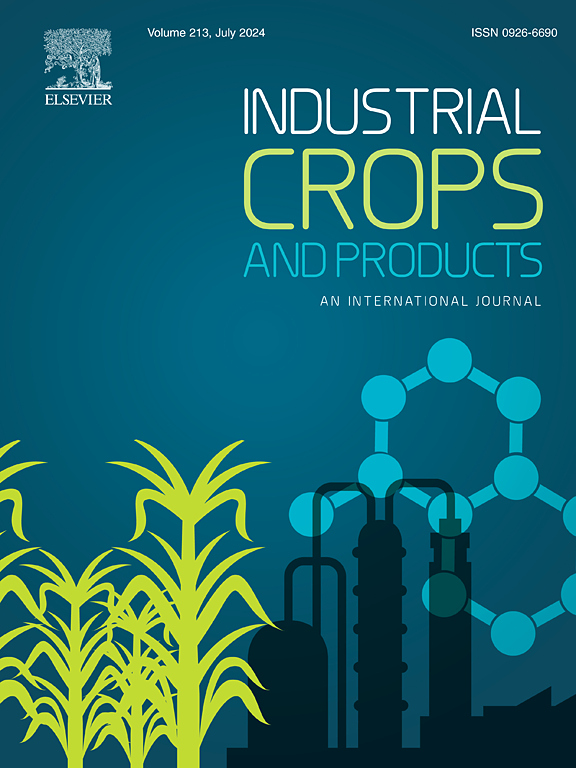Genome-wide identification, expression analysis of the MYC gene family in Stevia rebaudiana and the functional identification of SrMYC8 in SGs biosynthesis
IF 5.6
1区 农林科学
Q1 AGRICULTURAL ENGINEERING
引用次数: 0
Abstract
Stevia is an essential source of natural sweeteners-SGs. The MYC genes play crucial roles in modulating multiple biological processes. However, the functions of SrMYCs in Stevia remain poorly understood. SrMYCs were identified and characterized using bioinformatic methods for their physicochemical properties, phylogeny, genetic structures, conserved sequences, motif compositions, duplication patterns, chromosomal locations, and cis-acting elements. RNA-seq data were used to analyze the correlation between SrMYCs and SGs. Additionally, the expression patterns of SrMYCs were detected by RT-qPCR in various tissues and under diverse abiotic stresses. The function of SrMYC8 was validated through transient transformation, and the downstream target gene of SrMYC8 was investigated using Y1H experiments. 19 SrMYCs were identified from the Stevia genome and classified into 5 subgroups based on phylogeny. Cis-acting elements analysis revealed multiple elements involved in growth and development, light response, phytohormone signalling and abiotic stress, suggesting that SrMYCs play diverse physiological roles. Correlation analysis between SrMYCs and SGs identified SrMYC9/12/14/17 as potentially involved in SGs biosynthesis. The RT-qPCR analysis revealed that SrMYC8/9/12/14/17 differentially expressed in various tissueswith SrMYC8 was most highly expressed exhibiting the highest expression in mature leaves. Furthermore, these genes differentially expressed under various stresses, especially in response to MeJA and salts. Subcellular localization analysis confirmed SrMYC8 function within the nucleus. Transient transformation and Y1H experiments demonstrated that SrMYC8 enhances the expression of SrUGT91D2 by directly targeting its promoter. This study offers novel insights into the functions of the SrMYCs and regulation of SGs biosynthesis, providing valuable genetic resources for Stevia molecular breeding.
甜菊糖MYC基因家族的全基因组鉴定、表达分析及SrMYC8在SGs生物合成中的功能鉴定
甜菊糖是天然甜味剂sgs的重要来源。MYC基因在调节多种生物过程中发挥重要作用。然而,甜菊糖中SrMYCs的功能仍然知之甚少。利用生物信息学方法对SrMYCs的理化性质、系统发育、遗传结构、保守序列、基序组成、重复模式、染色体位置和顺式作用元件进行了鉴定和表征。RNA-seq数据用于分析SrMYCs与SGs之间的相关性。此外,通过RT-qPCR检测SrMYCs在不同组织和不同非生物胁迫下的表达模式。通过瞬时转化验证SrMYC8的功能,并通过Y1H实验研究SrMYC8的下游靶基因。从甜叶菊基因组中鉴定出19个SrMYCs,并根据系统发育将其分为5个亚群。顺式作用元件分析揭示了SrMYCs参与生长发育、光响应、植物激素信号和非生物胁迫的多个元件,表明SrMYCs具有多种生理作用。SrMYCs与SGs的相关性分析鉴定出SrMYC9/12/14/17可能参与SGs的生物合成。RT-qPCR分析显示,SrMYC8/9/12/14/17在不同组织中表达差异较大,其中SrMYC8在成熟叶片中表达量最高。此外,这些基因在不同的胁迫下表达差异,特别是对MeJA和盐的反应。亚细胞定位分析证实了SrMYC8在细胞核内的功能。瞬时转化和Y1H实验表明,SrMYC8通过直接靶向SrUGT91D2的启动子,增强了SrUGT91D2的表达。该研究为研究SrMYCs的功能和SGs生物合成调控提供了新的思路,为甜菊糖分子育种提供了宝贵的遗传资源。
本文章由计算机程序翻译,如有差异,请以英文原文为准。
求助全文
约1分钟内获得全文
求助全文
来源期刊

Industrial Crops and Products
农林科学-农业工程
CiteScore
9.50
自引率
8.50%
发文量
1518
审稿时长
43 days
期刊介绍:
Industrial Crops and Products is an International Journal publishing academic and industrial research on industrial (defined as non-food/non-feed) crops and products. Papers concern both crop-oriented and bio-based materials from crops-oriented research, and should be of interest to an international audience, hypothesis driven, and where comparisons are made statistics performed.
 求助内容:
求助内容: 应助结果提醒方式:
应助结果提醒方式:


